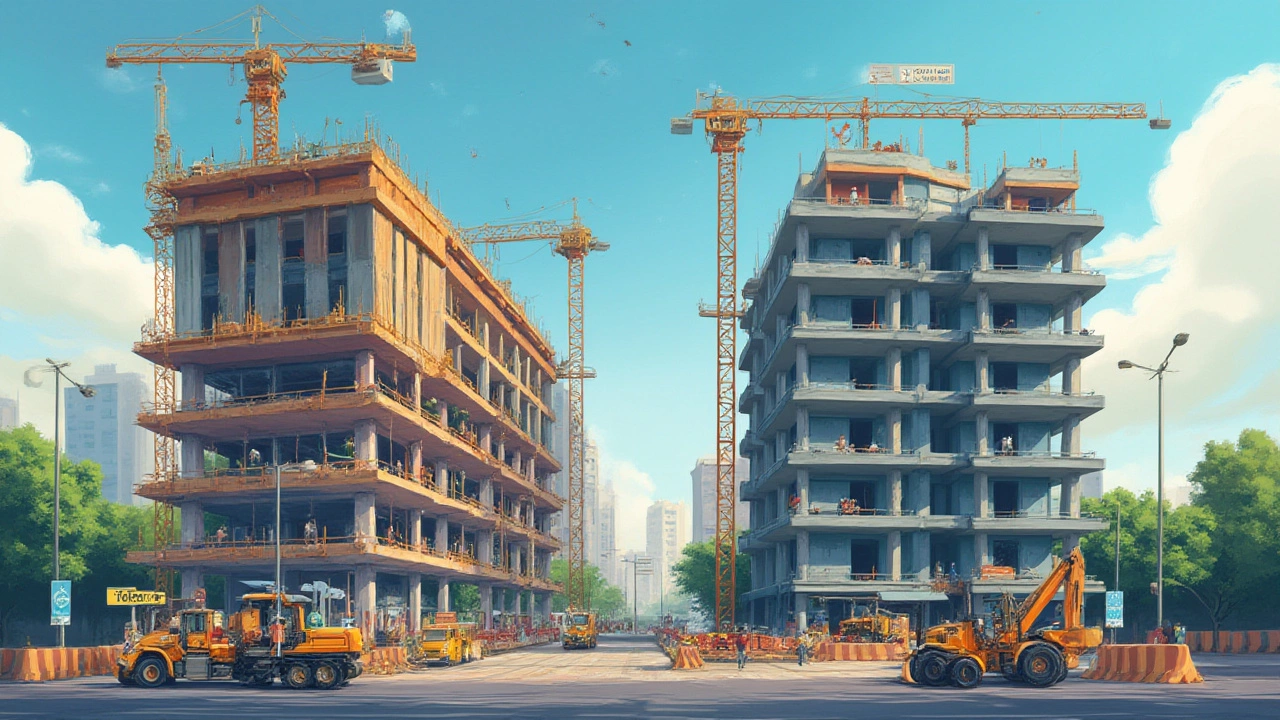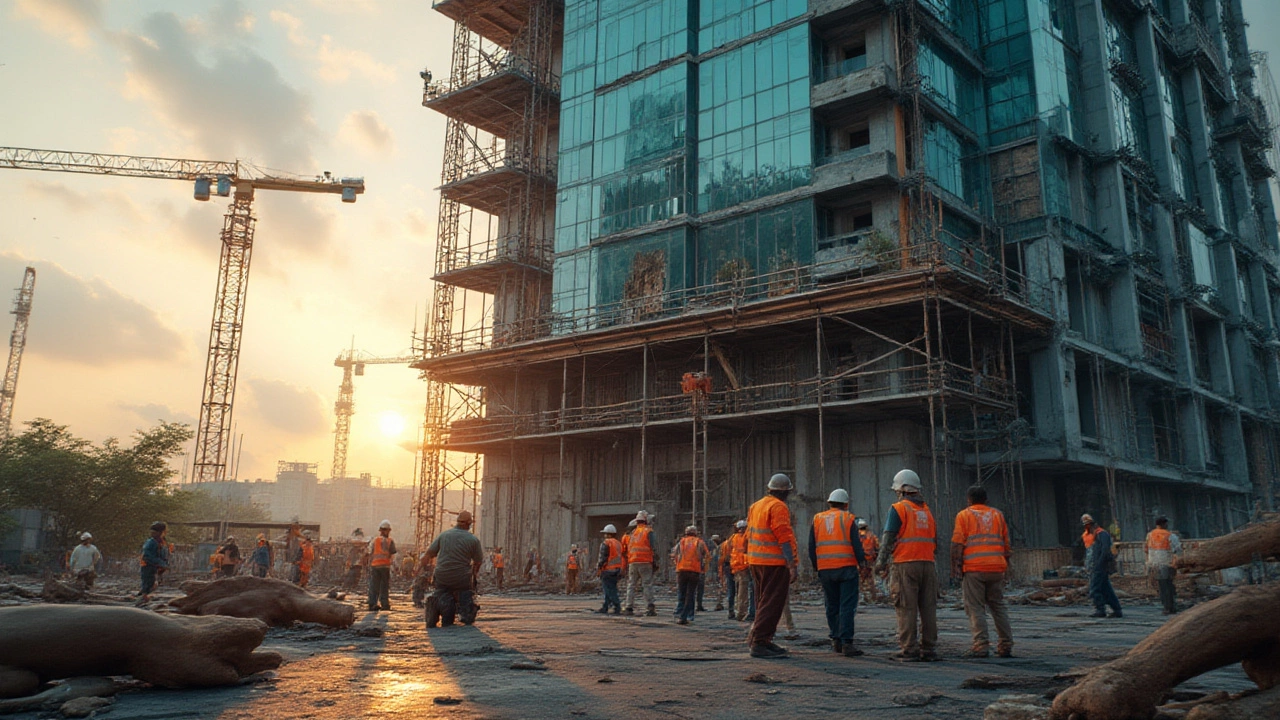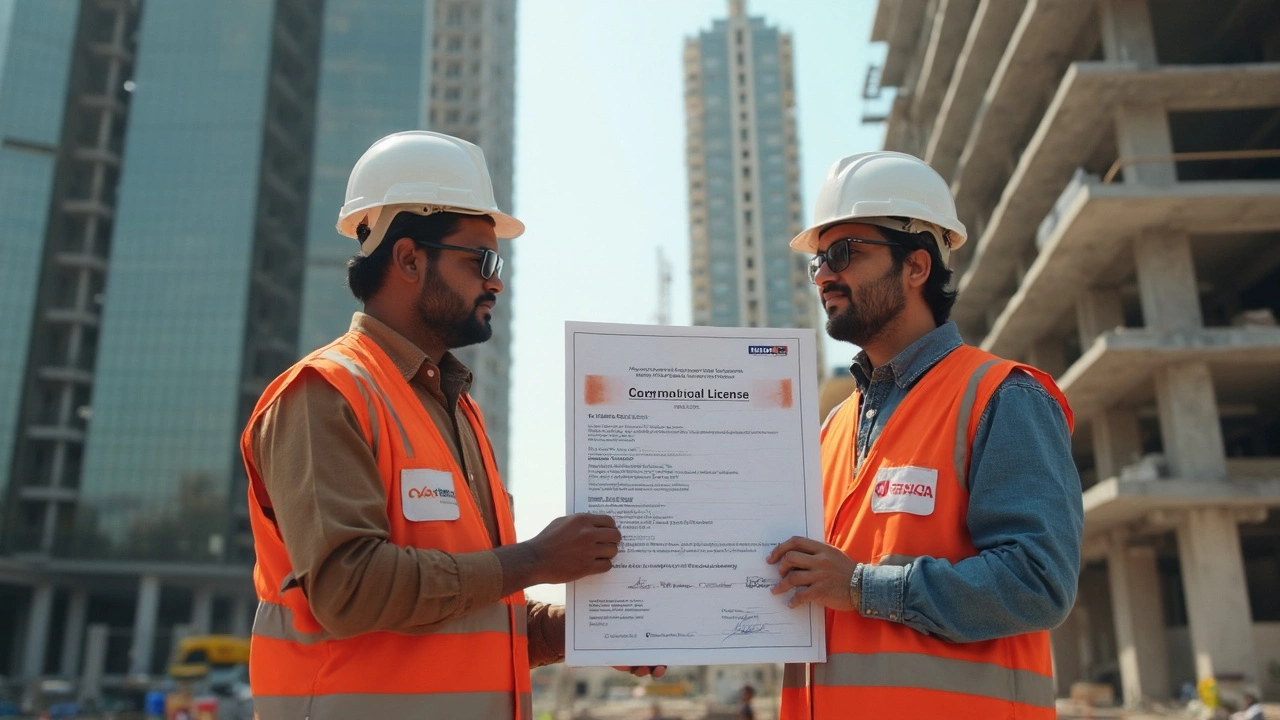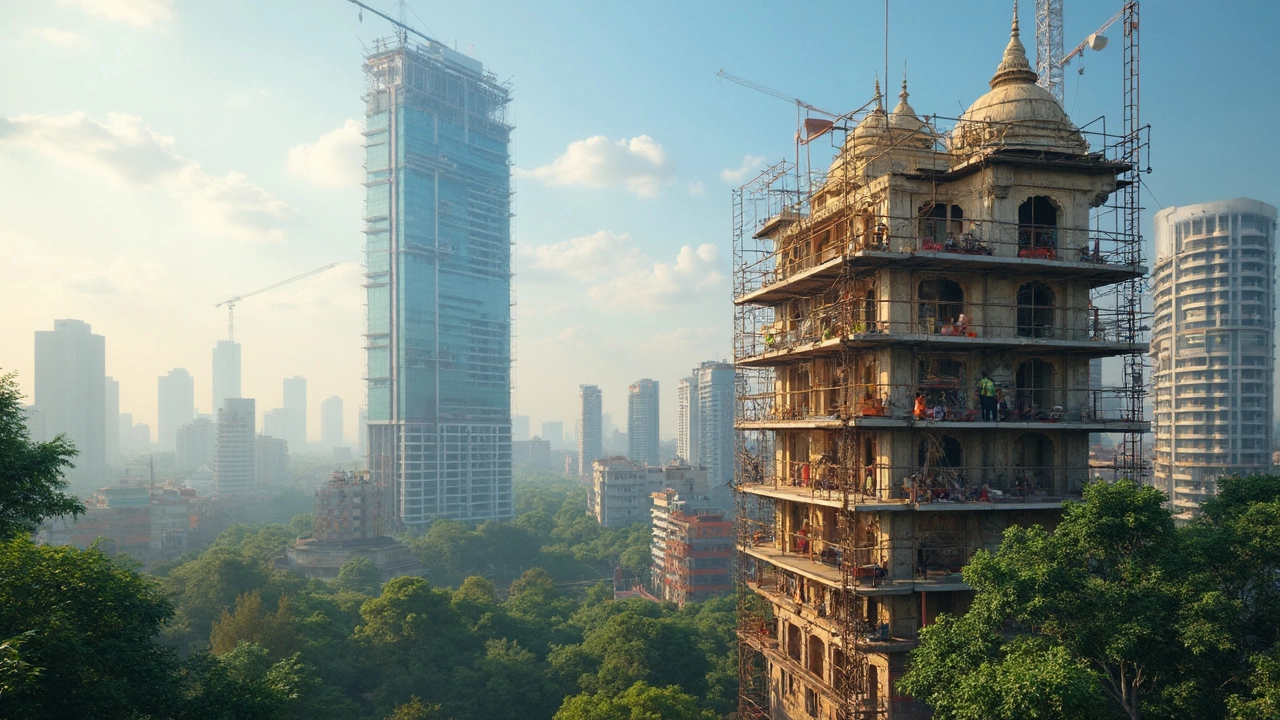Walk through the city, and every structure tells a story. But is every new building site a commercial job, or does it fall into that mysterious 'non-commercial' box? Here's the catch: not all hammers and hard hats are working for the same team. The lines between commercial and non-commercial construction shape not just what gets built, but how people live and do business every day.
Defining Commercial Construction: More Than Just Big Business
When most folks hear "commercial construction," they think glass towers or strip malls. But it’s a broad field stretching across retail, offices, hotels, restaurants, shopping centers, medical clinics, big-box warehouses, and more. The key? These projects are built for profit. It doesn’t have to mean they’re gigantic—a humble local café build counts as commercial simply because it’s designed around money-making activity. State stats released in 2024 show that commercial projects account for nearly 42% of all construction value in New Zealand, showing just how significant they are to both the economy and urban lifestyle.
What sets commercial work apart isn’t only size, but complexity. Zoning laws can be intense. Buildings must meet strict fire safety, accessibility, and public-health rules. For example, a commercial childcare center must include special play areas, wheelchair points, and evacuation strategies—features rarely required in typical homes. Plus, deadlines are usually tight. Construction companies might be penalized heavily for running late because every day a site isn’t open for business means lost income.
Commercial projects pull together architects, engineers, city planners, specialty contractors, interior designers, and sometimes even landscape artists—more moving parts than you’ll find in most non-commercial builds. And when things go wrong, the fallout’s bigger. A leaky window in a retail store could mean lost merchandise or unhappy customers, not just inconvenience for a resident.
Financing also differs. Commercial projects usually rely on business loans, bank financing, or investors. There’s rarely a mortgage in the sense homeowners use. The permits stack up higher too. In Wellington, for instance, council checklists for commercial builds run almost double the length of residential ones, listing everything from seismic upgrades to public parking requirements.
Here are a couple tips for anyone stepping into commercial construction:
- Get to grips with local business zoning rules and compliance points before buying land—these can scuttle a project before you even start.
- Plan to work with a project manager who knows the ropes, especially on big builds—experience saves time and money.
- Budget for the unexpected. Everything from city traffic requirements to supply chain hiccups can tack cost onto a commercial project.
- If you’re building for tenants (like restaurants or shops), design with their likely needs in mind—a flexible space gets leased faster.
Non-Commercial Construction: Homes, Dreams, and Community Spaces
Now let’s talk about everything that isn’t business-driven. Non-commercial construction usually covers stuff built for people, not profits. Most often, we’re talking about houses, apartments, and rest homes—but it also includes schools, churches, libraries, community halls, museums, and sometimes public sports facilities or parks.
Here’s one quirky fact: Most construction permits in smaller New Zealand towns actually go to non-commercial projects, supporting the idea that building homes and communities is still the heart of building work outside big urban centers. The process can feel friendlier, but it’s not simpler. Regulations—especially for new home builds—still demand insulation, energy efficiency, earthquake strengthening (yes, even out here in Wellington), and basic accessibility. But the paperwork stack is shorter, focused on residential building codes instead of endless commercial checklists.
That said, non-commercial builds often dip into personal emotion. People want custom spaces, more natural light, or an open-plan living area for big family dinners. Designs are more about comfort and daily living than profit per square meter. Still, mistakes cost money, and delays turn dreams into stress.
Public projects like schools or libraries bring communities together during the planning phase. Parents, teachers, city leaders—all pitch in ideas. Fundraising might be involved, local businesses might sponsor playgrounds or murals, and everyone watches eagerly as foundation piers go in. But these are still non-commercial because the goal isn’t profit, it’s public benefit.
If you’re planning a non-commercial build, here’s what to watch for:
- Pay attention to community input—neighbors care deeply about how a project affects them, especially with public spaces.
- Be realistic about timelines—small errors add up, especially if a family is living elsewhere during a tricky home renovation.
- Factor in energy efficiency and future maintenance. Modern insulation and smart design save heaps in the long run.
- Keep pets safe—my dog Rocky once gnawed on a paintbrush during our kitchen redo, so don’t let yours loose near open cans or tools!
Non-commercial construction shapes daily lives. From the street you walk to your front door, to the greenery outside the office window, these projects keep communities feeling like home.

Comparing Commercial and Non-Commercial Construction
It’s easy to lump all builders together, but here’s where the differences truly jump out. One main divide is the rules and standards every project must follow, especially around safety, accessibility, and environmental impact. Take a look at this breakdown:
| Aspect | Commercial | Non-Commercial |
|---|---|---|
| Primary Purpose | Profit/Business | Personal/Community Use |
| Common Examples | Offices, stores, hotels | Homes, schools, churches |
| Permitting | Complex and lengthy | Shorter, residential-focused |
| Regulations | Business codes, health & safety, public access | Residential codes, family safety |
| Financing | Loans, investors, business funding | Mortgages, personal savings, public funds |
| Timeline | Strict, often tight deadlines | More flexible (but delays still costly) |
| Stakeholders | Owners, tenants, investors, regulatory bodies | Owners, families, communities, funders |
| Design emphasis | Functionality, profit, image | Comfort, lifestyle, community needs |
Here’s the wild bit: the same team might build both types, but they’ll tackle each completely differently. An architect designing an apartment block (commercial) is wrangling investor expectations, tenant needs, city codes, and architectural flair. The same firm, asked to design a new library (non-commercial), will instead juggle public input, accessibility for all ages, quiet zones, and tight council budgets.
Sometimes, projects blur the lines. Think of a hospital—it serves the public (non-commercial), but private clinics inside might rent space (commercial). Or a mixed-use development, where ground-floor shops support upstairs flats. But as a rule, if profitability leads every step, it lands on the commercial side of the fence. If the users are mainly families or communities, and profit isn’t the driver, it’s non-commercial.
Each type brings special benefits and headaches. Commercial projects create jobs and energize downtowns, but can change a neighborhood's vibe. Non-commercial projects add heart, but can be slow to fund and build.
Why It Matters: Taxes, Insurance, and The Law
Here’s a spot most people overlook: whether a project is commercial construction or not can shape your bottom line for years. Tax rules treat business and personal buildings differently. Insurance policies for an office tower look nothing like those for a bungalow. If a builder mislabels the type—whether by mistake or design—council fines or legal trouble could come knocking.
If you’re planning to lease out a space, the type of construction affects your rental agreements. Commercial leases usually run longer, with tenants responsible for more upkeep and upgrades. Non-commercial leases—think renting out a spare room—fall under totally different rules, and even landlord insurance flips between the two. In many places, failing to declare a commercial arrangement in a residential property can void your insurance altogether.
Here’s a stat: in the last three years, nearly 19% of legal disputes in New Zealand construction arose from blurred lines between commercial and non-commercial building use—usually around insurance or planning permissions. Smart property owners and developers get things crystal clear from day one.
The type also drives eligibility for government help. Plenty of grants or low-rate loans target non-commercial builds, like eco-friendly schools or affordable housing. But commercial developers usually need to look to classic finance. Mixing the two can be a paperwork nightmare. Even banks ask for different documentation and proofs of income, depending on which bucket a project falls into.
If you ever take on a build project, double check your classification with local regulators. Kiwi councils (especially Wellington) are strict, and they’ve got eyes everywhere. Your property’s council file can follow it for decades, tripping up future renovations or sales if there’s an error now.

Choosing the Right Path for Your Project
Once you know the differences, the next step is figuring out which process fits what you want to build. Someone hoping to launch a small B&B by the coast falls under commercial construction rules, even if it feels residential. On the flip side, a home garage addition stays non-commercial—unless you plan to run a mechanic shop out of it.
If you're new to building, here's some advice:
- Be up front with your builder or architect about your intended use—commercial codes can sneak up on renovations if there’s any money-making involved.
- Check your site’s zoning on your council’s website before you buy or draw up plans. Some zones don’t allow for business use, others are wide open. This can make or break your project.
- Budget at least 15% above your initial costings—both commercial and non-commercial builds seem to inevitably uncover surprises once the digging starts.
- Ask about timelines, both official (like permits) and realistic (like weather delays). Even with all the planning in the world, Wellington’s winds can shut down a day’s work in flat minutes.
If you’re curious what type your project is, ask for advice early. Many Kiwi councils—including Wellington’s—let you book quick consults with building inspectors who’ll point you in the right direction, saving months of grief and thousands of dollars.
When you’re walking Rocky around the block and spot a building site, take a closer look—you’ll spot clues to its type in the fencing signage, the scale of the work, and sometimes even the suits mingling with the hi-vis vests. From that point on, construction isn’t just hammers and nails—it’s a story about who and what these structures are truly built for.




